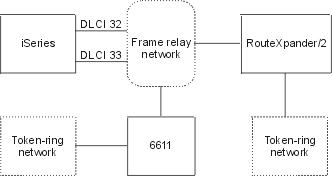This scenario involves connecting an IBM®  iSeries™ system
on a frame-relay network to systems on two remote token-ring networks. The
6611 Network Processor and IBM PS/2® computer-based RouteXpander/2 are used as bridges
between the frame-relay network and the remote local area networks (LANs).
iSeries™ system
on a frame-relay network to systems on two remote token-ring networks. The
6611 Network Processor and IBM PS/2® computer-based RouteXpander/2 are used as bridges
between the frame-relay network and the remote local area networks (LANs).
Figure 1 shows the configuration of an iSeries system for frame-relay communications with devices on two different token-ring networks.
One token-ring network is connected using a 6611 Network Processor as a bridge. The other is connected using a RouteXpander/2.
The T1 connection into the frame-relay network is configured by using two data link connection identifiers (DLCIs), with each providing a link to one of the bridges. DLCI 32 defines a permanent virtual circuit (PVC) to the RouteXpander, and DLCI 33 defines a PVC to the 6611.
The source route bridging protocol is carried out on both bridges in this configuration. Both Systems Network Architecture (SNA) Advanced Program-to-Program Communication (APPC)/Advanced Peer-to-Peer Networking (APPN) and TCP/IP traffic are possible in these configurations. The TCP/IP configuration for lines ROUTE6611 and ROUTEEX is done similarly to the way all token-ring network lines are configured for TCP/IP on the iSeries system.
